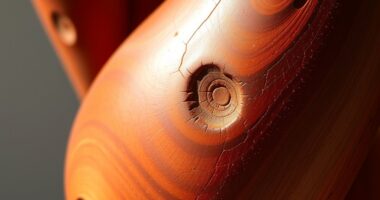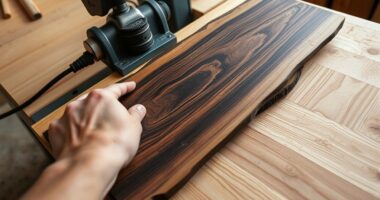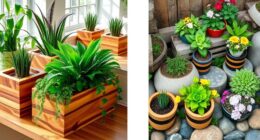Hardwoods come from deciduous trees with broad leaves, grow slowly, and have dense, intricate grain patterns, making them ideal for furniture and flooring. Softwoods come from coniferous trees with needles, grow faster, and have lighter, straight grains, suited for framing and outdoor uses. Their differences affect durability, appearance, cost, and sustainability. Want to discover more about how to choose the right type for your project? Keep exploring these key distinctions.
Key Takeaways
- Hardwoods come from deciduous trees with complex grain patterns; softwoods originate from coniferous, needle-leaved trees with straight grains.
- Hardwoods grow slowly, taking decades to mature; softwoods grow faster, often within 40 years.
- Hardwoods are denser, durable, and ideal for furniture; softwoods are lighter, more flexible, and suited for construction.
- Softwoods are more abundant and affordable due to rapid growth; hardwoods are scarcer and more expensive.
- Both can be sustainably harvested with proper forestry practices, but hardwoods require longer cycles, impacting availability.
Defining Hardwoods and Softwoods

Hardwoods and softwoods are classifications based on the reproductive features of the trees they come from, not their physical hardness. Hardwoods come from deciduous tree species, which are angiosperms that shed their leaves annually. Softwoods originate from gymnosperm trees, typically evergreen with needle-like leaves. This classification hinges on seed type and flowering, not texture or density. Hardwoods generally grow more slowly, resulting in denser, more durable timber, while softwoods tend to grow faster and are lighter. Examples include oak, maple, and walnut for hardwoods, and pine, cedar, and spruce for softwoods. Keep in mind, the classification doesn’t always match physical hardness—some hardwoods can be soft, and some softwoods can be hard—it’s about their reproductive features and growth rates. Additionally, understanding the growth characteristics of each type can help in selecting the appropriate wood for various projects. Recognizing these differences can also influence the durability and suitability of the wood for specific applications. Moreover, environmental factors such as climate and soil conditions play a significant role in the growth and quality of different wood types.
Origins and Tree Types

The origins and botanical classifications of trees determine whether they produce hardwoods or softwoods. Hardwoods come from deciduous trees, which are angiosperm trees that shed their broad leaves annually. These trees produce seeds enclosed within fruits or flowers. Softwoods, on the other hand, originate from gymnosperm conifers, which are evergreen trees with needle-like leaves. They produce seeds on cones without flowers.
Hardwoods come from deciduous trees with broad leaves; softwoods from evergreen conifers with needle-like leaves.
- Hardwoods include species like oak, maple, and walnut, originating from broad-leaved, flowering trees.
- Softwoods include pine, cedar, and spruce, derived from conifers with needle-like leaves.
- Deciduous trees tend to grow slower, taking decades to mature, while gymnosperm conifers grow faster.
- The classification hinges on reproductive features, not wood softness or density.
Visual and Structural Characteristics
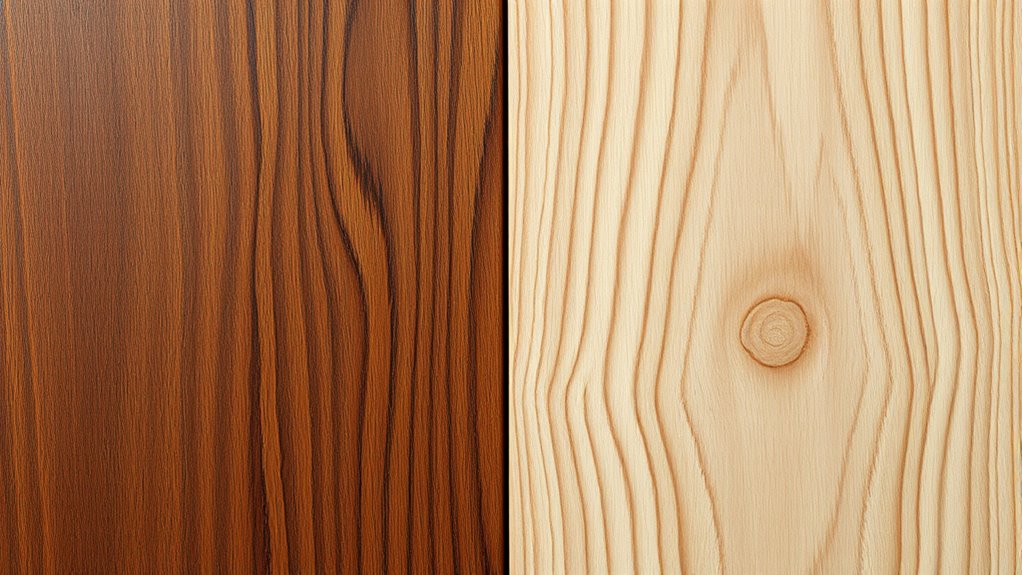
You’ll notice that hardwoods often have intricate, wavy grain patterns and a darker, richer color, thanks to their complex cellular structure. Softwoods, on the other hand, feature straight, uniform grains and lighter shades, with a simpler structure without visible pores. These differences in appearance and density influence not only how the wood looks but also how it feels and performs in your projects. Additionally, the visual characteristics of each type are often used to identify and distinguish between them.
Grain Patterns and Appearance
Because of their complex cellular structure, hardwoods display intricate grain patterns characterized by visible pores called vessels. This results in a rich, diverse appearance with prominent grain lines and notable grain variations. The grain pattern often appears wavy, curly, or figure-like, adding visual interest. In contrast, softwoods have simpler, more uniform grain lines, creating a clean, straight look. Their lack of visible pores leads to a more consistent appearance. The grain characteristics of hardwoods make them ideal for decorative projects, while softwoods are preferred for applications requiring a lighter, more subdued look. Additionally, grain patterns can influence the durability and workability of the wood in different projects. Understanding these differences can help in selecting the right type of wood for your specific home improvement needs. Moreover, knowing the grain structure can assist in predicting how the wood will respond to environmental changes over time.
Cell Structure and Pores
Have you ever noticed the differences in the cellular makeup of hardwoods and softwoods? Hardwood cellular structure is more complex, featuring vessel pores that are visible to the naked eye. These pores create distinctive grain patterns and medullary rays, adding visual interest. In contrast, softwoods lack these vessel pores, resulting in a simpler, more uniform cellular arrangement. This absence makes softwoods less textured and softer to the touch. The cellular structure in hardwoods is dense, contributing to their heavier weight and increased strength. The presence or absence of pores directly influences grain appearance and how the wood interacts with stains and finishes. Additionally, the differences in cellular structure affect the wood’s durability and susceptibility to environmental factors. Overall, hardwoods have a more intricate cellular structure, while softwoods maintain a lighter, less complex cellular makeup.
Color and Density
When comparing hardwoods and softwoods, their visual and structural characteristics reveal clear differences in color and density. Hardwoods tend to have darker, richer colors like deep browns and reds, giving their appearance a warm, luxurious feel. Softwoods are generally lighter or pale, with yellowish or creamy tones. The grain in hardwoods often displays complex, wavy, or figured patterns, creating striking visual patterns, whereas softwoods usually have straight, simple grain lines. Their cellular structures also differ: hardwoods feature visible pores or vessels, contributing to higher density and weight, while softwoods have a more uniform structure. These differences influence both the visual appeal and physical properties of timber, affecting their suitability for various applications. Additionally, the cellular structure impacts how the woods respond to environmental conditions, with hardwoods typically being more durable in outdoor settings. Recognizing these differences in density can help in choosing the right type of wood for specific projects. Moreover, understanding the color variation can assist in selecting the ideal wood based on aesthetic preferences. Furthermore, the grain pattern can also influence how the wood is finished and its overall appearance in finished products.
Mechanical Strength and Durability

Hardwoods generally outperform softwoods in mechanical strength and durability, making them better suited for demanding applications. Their higher Janka hardness ratings mean they resist dents and scratches better, providing increased resistance to wear. The dense cellular structure of hardwoods gives them superior strength and durability, allowing them to support greater loads and resist warping over time. This makes hardwoods ideal for high-impact uses like flooring and furniture. Softwoods, on the other hand, tend to be less resistant to environmental factors and wear, often needing treatments for added durability. Overall, the inherent strength and cellular makeup of hardwoods make them more dependable for long-lasting, load-bearing, and high-traffic applications.
Density, Hardness, and Weight
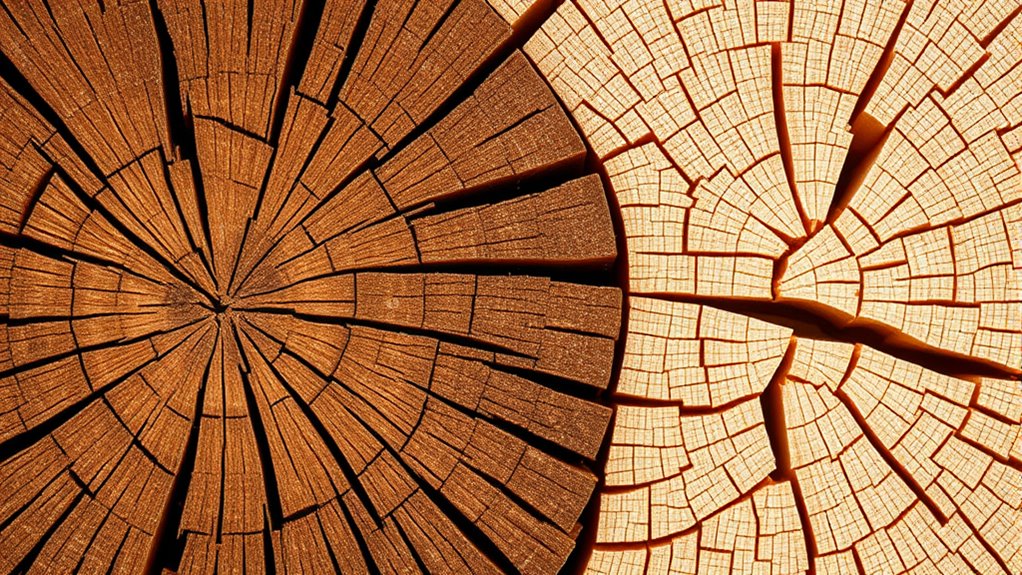
Hardwoods are typically denser and heavier than softwoods, which considerably impacts their strength and durability. This density difference means hardwoods often weigh more, making them suitable for high-stress applications. Hardness, measured by the hardness scale, varies widely; hardwoods like white oak reach around 1360 lbs, while softwoods like Western Red Cedar are about 350 lbs. This hardness influences resistance to dents and wear. The density and weight of wood significantly affect how they perform in various environments and projects, especially when considering material selection for specific needs. Additionally, the natural properties of hardwoods contribute to their aesthetic appeal and functionality in different applications. Factors like moisture content also play a crucial role in how wood reacts to environmental conditions, affecting its long-term performance.
Common Applications and Uses

Due to their durability and attractive appearance, hardwoods are often selected for high-end furniture, flooring, musical instruments, and decorative veneers. They are a versatile material suitable for applications that demand strength and aesthetic appeal. Hardwood species like oak and walnut are popular choices for furniture and cabinetry, especially in veneer form for a luxurious look. Softwoods, on the other hand, are commonly used in construction for framing, fencing, decking, and external cladding because they are affordable and readily available. Softwoods like pine and cedar are easy to work with, making them ideal for interior paneling and outdoor projects. Both hardwoods and softwoods serve different applications, with hardwoods mainly for interior and decorative uses, and softwoods for large-scale, cost-effective construction. Additionally, the selection often depends on the specific application requirements, such as durability, appearance, and cost. Understanding the local regulations and market trends can also influence the choice of wood for particular projects, especially in different regions. Furthermore, the availability of regional wood species can impact material choice depending on local forestry practices. A better understanding of wood properties can help in making more informed decisions for various projects. Moreover, considering the sustainability of the wood source is increasingly important for environmentally conscious construction and design choices.
Cost, Availability, and Sustainability

Softwoods are more affordable because they grow quickly and are readily available, making them a popular choice for many projects. Hardwood trees take much longer to mature, which raises costs and affects sustainability. Overall, softwoods tend to have a smaller environmental impact due to their faster renewal, while hardwoods offer durability at a higher price. Additionally, outdoor living and design elements often utilize softwoods for their ease of use and cost-effectiveness. For certain applications, understanding the composition and growth cycles of these woods can help in making sustainable choices.
Growth Rate and Supply
Because softwoods grow quickly, they reach harvestable size in about 40 years, making them more plentiful and affordable. Their fast growth rate assures a steady supply, supporting large-scale, sustainable harvesting. Softwoods are typically grown in plantations and managed forests, which enhances their availability and reduces pressure on natural ecosystems. In contrast, hardwoods take up to 150 years to mature, limiting their supply and increasing costs. This slower growth results in scarcer resources and less consistent availability. Softwoods’ rapid growth cycle makes them a renewable resource that can meet demand without depleting forests. Their sustainable supply supports environmental goals and provides a reliable material source for diverse projects. Overall, softwoods’ growth rate and supply advantages make them a practical choice for many applications.
Price and Market Cost
The faster growth rate and greater abundance of softwoods directly influence their market price and availability, making them more accessible and affordable for a wide range of projects. Softwoods generally have a lower market cost because their harvesting costs are reduced, thanks to their quick growth and widespread availability. In contrast, hardwoods tend to be more expensive due to slower growth, longer harvesting cycles, and higher quality characteristics that increase their market cost. Softwoods make up about 80% of the global lumber market, reflecting their affordability and easy access. Additionally, softwoods are often seen as more sustainable because they can be harvested and replanted more frequently, supporting ongoing supply. Hardwood, on the other hand, commands higher prices suited for luxury or high-end applications.
Environmental Impact and Renewal
Since softwoods grow rapidly, they are generally more sustainable and easier to replenish, making them a greener choice for many projects. Their fast growth rate shortens harvesting cycles, enabling more efficient replanting and reducing environmental impact. This quick turnaround supports responsible forestry and promotes renewable resources. Conversely, hardwoods take 80-150 years to mature, leading to longer harvesting cycles and increased environmental concerns if not managed carefully. Overharvesting hardwoods can threaten forest health, especially without proper replanting. Both types can be harvested sustainably through certification programs like FSC and PEFC, which emphasize responsible forestry practices. Ultimately, softwoods’ rapid growth and renewability make them a more environmentally friendly option, while hardwoods require more careful management to ensure ongoing sustainability.
Workability and Processing

Hardwoods tend to be more challenging to work with due to their higher density and complex cellular structure, which often requires specialized tools and techniques. Their dense nature and intricate grain patterns make cutting, shaping, and machining more demanding, often resulting in increased tool wear and longer processing times. You’ll need sharper blades and more power during machining to achieve clean cuts and precise shapes. Softwoods, with their lower density and simpler grain patterns, are easier to work with, allowing you to saw, nail, and drill with standard tools quickly and efficiently. Proper grain orientation and moisture control are vital for both types during processing, ensuring smooth workability and a high-quality finish. Overall, hardwoods demand more effort but offer distinctive aesthetic and structural qualities.
Environmental Impact and Conservation

When considering the environmental impact of wood types, softwoods typically have a lower ecological footprint because they grow quickly and can be harvested more sustainably. They are often cultivated in plantations designed for rapid regeneration, reducing pressure on natural forests. Hardwood harvesting, on the other hand, involves longer regeneration periods—sometimes up to 150 years—which raises concerns about overharvesting and habitat loss. To mitigate these issues, certified sustainable forest practices like FSC and PEFC ensure responsible sourcing and promote conservation efforts. By choosing forest products from sustainably managed sources, you support ecological balance and help prevent deforestation. Softwood plantations and responsible harvesting methods play a crucial role in maintaining sustainable forestry and protecting biodiversity.
Choosing the Right Wood for Your Project

Choosing the right wood for your project depends on understanding the specific qualities each type offers. When comparing hardwood vs softwood, consider their wood properties and application suitability. Hardwoods like oak or walnut are ideal for furniture and flooring due to their durability and resistance to wear. Softwoods such as pine or cedar are better suited for framing, large-scale construction, or exterior use because they’re lightweight, flexible, and easier to work with. Growth rates influence environmental impact and availability; softwoods grow faster and are more sustainable, making them a budget-friendly choice. Match your project requirements with these factors: dense hardwoods for durability and fine finishes, or softwoods for affordability and ease of use. Selecting the right type guarantees your project’s success.
Frequently Asked Questions
What Is the Main Difference Between Softwood and Hardwood?
The main difference is their botanical classification: softwoods come from evergreen conifers, and hardwoods come from deciduous trees that shed leaves annually. Softwoods are lighter and grow faster, making them easier to work with, while hardwoods are denser and more durable due to slower growth. Remember, some hardwoods are soft, and some softwoods are hard, so appearance and density don’t always match their names.
Is Pine a Hardwood or Softwood?
They say “what’s good for the goose is good for the gander,” and in this case, pine is a softwood. You should know that pine comes from conifer trees, which are evergreens with needle-like leaves. It’s lightweight, affordable, and easy to work with, making it perfect for furniture and construction. Its cellular structure lacks pores, and it’s softer and less dense than hardwoods, fitting neatly into the softwood category.
Is Oak a Hardwood or Softwood?
You might wonder if oak is a hardwood or softwood. Oak is classified as a hardwood because it comes from deciduous trees that shed leaves annually. Its dense, durable wood, high Janka hardness, and slow growth rate all point to it being a hardwood. Despite its name, oak isn’t soft—it’s valued for strength, toughness, and attractive grain, making it ideal for furniture and flooring.
Is Apple a Hardwood or Softwood?
You’re asking if apple is a hardwood or softwood. Apple wood comes from deciduous trees that shed leaves annually, making it a hardwood. It features a dense, complex grain, and is durable, ideal for fine woodworking and musical instruments. Despite being lightweight compared to other hardwoods, it maintains the qualities of dense, strong timber. So, yes, apple wood is classified as a hardwood, valued for its beauty and durability.
Conclusion
Choosing between hardwood and softwood isn’t just about strength or cost—it’s about understanding their origins and your project needs. While hardwoods offer durability and elegance like a solid oak table, softwoods bring versatility and affordability, much like pine framing. By weighing these contrasts, you can select the perfect wood, blending your vision with practicality. Ultimately, whether you prefer the richness of hardwood or the ease of softwood, your choice shapes your craft’s story.




